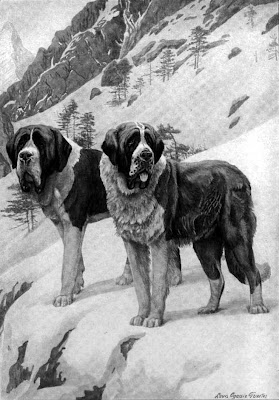Wednesday, September 03, 2008
St. Bernard
Some of the dogs kept at the hospice now resemble powerful foxhounds and would never
be admitted to an American bench show in competition with modern St. Bernards, either
smooth or rough coated.
The old-time working hospice dog had none of the grandeur of this more modern successor to his name, which has been compounded rather recently of several other dogs. Still he is about the most distinct of any of the large dogs, the Newfoundland being the only dog even remotely resembling him.
Like all very large heavy dogs, this breed is greatly given to weakness in the legs, cowhocks and weak hips being rather the rule than the exception. The "dewclaw," or extra hind toe, is also generally present (and was formerly considered desirable).
The perfect St. Bernard is a very large, very strong, straight-backed, strong-legged, and heavily organized dog, the colors, as shown, being those most eagerly sought. They may be either rough or smooth in coat. The best American dogs are those of Mr. Jacob Rupert, of Newark, N. J., and Miss C. B. Trask, of California. Indeed, it is doubtful if their dogs are to be surpassed anywhere.
The benign St. Bernard should show, in both types, broad, domed, massive head, loose skin, deep-set, rather mournful, eye, haw quite pronounced, and deep-folded flews and dewlap, though he should not be too "throaty." What is not mentioned in most brief accounts of this dog is the tremendously impressive voice in which he speaks. Probably no other dog has such a deep bass voice, nor such a volume of it. Yet it is as benign and kindly as his expression of countenance, and would tend rather to inspire hope and confidence than fear, even with the timid.
The deep personal affection with which St. Bernard owners invariably invest their companions is the best expression of the character of these great, dignified and rather somber dogs, which inspire no fear, even in little children, and which return the stranger's gaze with a look of calm, steady, and indulgent tolerance, and endure the advances of the unacquainted with a patience and dignity that speak worlds for their gracious and enduring disposition.
From The Book of Dogs: An Intimate Study of Mankind's Best Friend By National Geographic Society (U.S.), Louis Agassiz Fuertes, Ernest Harold Baynes Published 1919. 109 pages Original from Harvard University.
This image (or other media file) is in the public domain because its copyright has expired.
This applies to the United States, where Works published prior to 1978 were copyright protected for a maximum of 75 years.
See Circular 1 "COPYRIGHT BASICS" from the U.S. Copyright Office. Works published before 1923 are now in the public domain In the United States,
This inage is also in the public domain in countries that figure copyright from the date of death of the artist (post mortem auctoris in thi case Louis Agassiz Fuertes (1874 – 1927) and that most commonly runs for a period of 50 to 70 years from that date. If your use will be outside the United States please check your local law.
Tags: Public Domain Clip Art and clip art or public domain and St. Bernard

2 comments:
I have been a fan of your blog a long time. I thought you might want to see an amazing public domain site. Yes, it is paid, but it is high resolution with *no* restrictions on use. And the selection is amazing :)
www.vintageartdownload.com
Thank you for doing what you do. You have a lot of fans out here :)
*blush*,thank you jennifer for your sweet words and the link to www.vintageartdownload.com
all the best,
sookie
Post a Comment